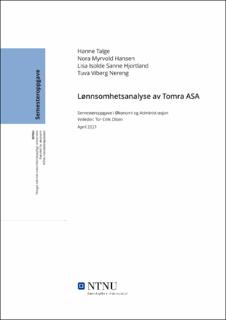| dc.contributor.advisor | Olsen, Tor-Eirik | |
| dc.contributor.author | Talge, Hanne | |
| dc.contributor.author | Hansen, Nora Myrvold | |
| dc.contributor.author | Hjortland, Lisa Isolde Sanne | |
| dc.contributor.author | Nereng, Tuva Viberg | |
| dc.date.accessioned | 2021-09-14T17:18:06Z | |
| dc.date.available | 2021-09-14T17:18:06Z | |
| dc.date.issued | 2021 | |
| dc.identifier | no.ntnu:inspera:80218484:80305879 | |
| dc.identifier.uri | https://hdl.handle.net/11250/2777241 | |
| dc.description.abstract | I denne semesteroppgaven har vi utført en lønnsomhetsanalyse av Tomra ASA i perioden 2015-2019. Tomra er et norsk selskap som tilbyr relevante løsninger for å redusere to av de største miljøutfordringene: forsøpling og utslipp av drivhusgasser. De er ledende leverandør globalt og opererer innenfor virksomhetsområder innsamling og sortering. Per i dag har de 70% markedsandel innenfor pantemarkedet, som var utgangspunktet for arbeidet med denne oppgaven.
For å se på bedriftens helhetlige utvikling i lønnsomhet har vi valgt å bruke sentrale nøkkeltall innenfor likviditet, finansiering, soliditet og lønnsomhet. Det at vi har valgt flere nøkkeltall innenfor områdene gir også informasjon om utviklingen på detaljnivå. Tomra påvirkes i stor grad av ytre faktorer som fremkommer av den strategiske analysen som inneholder PESTEL og SWOT. For å få gode og utfyllende analyser har vi hentet inn informasjon gjennom et personlig intervju med Georgina Radulescu, Director for Investor Relations.
Vi har valgt å sammenligne Tomra med Envipco, som er en konkurrent innen pantevirksomheten. Tomra har ikke noen konkurrenter som opererer innenfor begge virksomhetsområdene, og det var derfor en utfordring å gjennomføre en benchmark som skapte et helt riktig bilde. Likevel var benchmarken en god rettesnor på at Tomra har god lønnsomhet.
Av nøkkeltallene kan det observeres at det ikke har vært store endringer i den 5-årige perioden, og flere av tallendringene skyldes lovendringer i IFRS. Årsaken til dette er at Tomra har fokusert på organisk vekst i den foregående perioden. | |
| dc.description.abstract | In this thesis, we have conducted a profitability analysis of the Norwegian company, Tomra ASA, in the time period 2015-2019. Delivering solutions that support and drive sustainability has always been at the core of what Tomra does, which means generating positive social and environmental impact and business value through their products and solutions. Tomra is number one in collections solutions and they have a 70% market share in the business area reverse vending.
In order to get a greater perspective of Tomra’s overall development in profitability, we have analyzed key figures related to liquidity, funding, solidity and profitability. By using several key figures, we are able to analyze the development in detail. As a supplement to the financial analysis, we have conducted a SWOT and PESTEL analysis, because the external factors have a large impact on Tomra. An interview with Director for Investor Relations, Georgina Radulescu, gave us additional information that we used as a supplement for our analysis.
We have chosen to compare Tomra with the competitor Envipco, which operates in the reverse vending machine market. Tomra has no competitors operating in both business areas which made it difficult to get a completely right image of the benchmark. Despite this, the benchmark confirmed that Tomra’s profitability generally is good.
The key figures show that for the past 5-years there have been no major changes in the profitability. Several of the variation in the figures are due to IFRS changes. The explanation is that Tomra have focused on organic growth in this period. | |
| dc.language | nob | |
| dc.publisher | NTNU | |
| dc.title | Lønnsomhetsanalyse av Tomra ASA | |
| dc.type | Bachelor thesis | |
